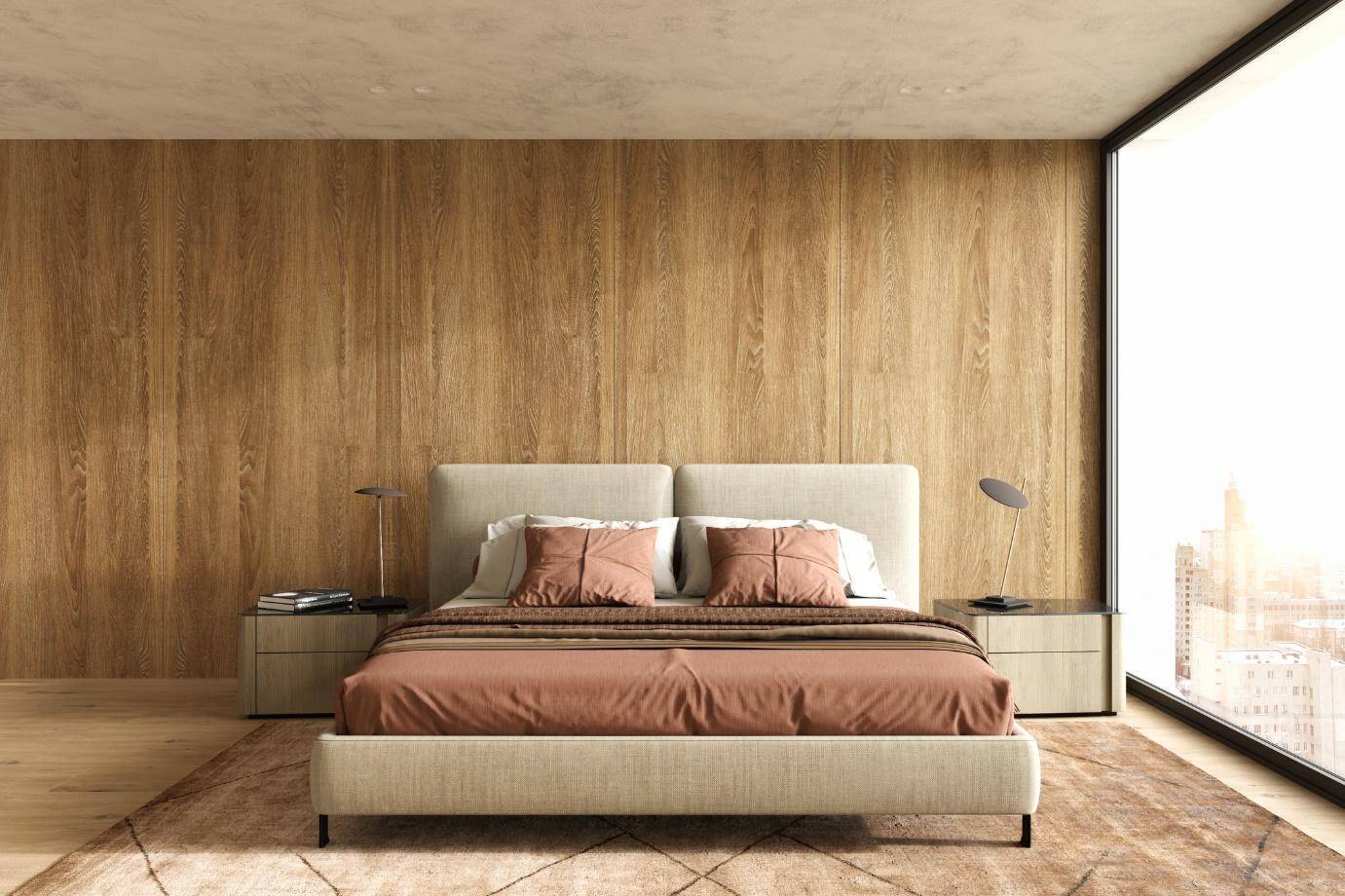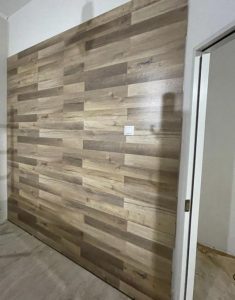Wall panelling is an historically popular way to protect interior and exterior walls from damp, wind, and rainfall. Today, all types of wall panelling can protect a home from adverse conditions. However, nowadays, it’s more popularly used as a fashionable way to decorate a home and create a lavish interior for a low price tag.
Wainscoting (now more commonly known as board and batten) became fashionable in the 16th century to protect the bottom third of a wall, particularly in bathrooms, from becoming damp. It was also a stylish way of hiding damp that had already formed on the lower parts of a wall.
Shiplap, another popular type of wall paneling, originated on ships to protect the exterior from the sea and create a watertight seal. Because of its success, it eventually became popular for use on the outside walls of seaside cottages to keep water out of the house.
Keep reading and we’ll explain the different types of wall paneling you can build for your home and how to hang decorative plywood on your wall.
What is Decorative Wall Paneling?
Decorative wall paneling is a popular alternative to tiling, plastering, and painting. It’s admired by homeowners because it adds texture, style, and insulation to interior and exterior walls. Wall panels can be directly applied to your wall to cover blemishes, poor paintwork, or Aertex. Once applied, the panels can be left as is (if they are pre-decorated) or they can be painted, or overlaid with wallpaper, fabric, or laminate.
What are the Types of Decorative Wall Panels?
In modern home décor, there are many types of wall paneling you can build from plywood as an easy DIY project. Most modern wall panels are designed for interior decoration, rather than exterior use. But, some types can be used for either, provided the plywood is weatherproofed. The most common types of wall panels for your home are:
- Shiplap
- Beaded panels
- Board and batten
- Tongue and groove
- Reclaimed wood
- Raised panels
- Flat panels
- Wood slats
- Planks
Overview: Types of Decorative Wall Panels Explained
As an overview, here are the different types of wall panels you can get, a brief description of what they look like, and a note of whether they can be used for the interior or exterior of your home.
| Type of Decorative Wall Panel | What Does It Look Like? | For Interior or Exterior Use? |
| Shiplap | Thin, rectangular sheets applied to walls in a horizontal pattern | Mostly exterior, but can be used interior |
| Beaded Panels | Are thin, rectangular panels fitted in a vertical pattern that interlock with a tongue and groove | Interior |
| Board and Batten | Usually fitted on the bottom third of the wall or floor to ceiling, has smooth boards with battens (raised beams) overlapping the boards in a box pattern | Originally developed for exterior walls, but is more popular in interiors today |
| Tongue and Groove | Similar design to shiplap, with thin, rectangular, horizontal planks, but have a small tongue and groove that enables a clean, smooth finish | Can be used for interior and exterior walls |
| Reclaimed Wood | Fitting a large, reclaimed piece of wood to walls, with a stained, painted, or sheened finish | Interior |
| Raised Panels | Typically prefabricated, raised panels are large, patterned boards fitted vertically | Interior |
| Flat Panels | Are large, smooth, flat panels fitted to walls, usually raised off the base wall with LED lights | Interior |
| Wood Slats | Are extremely thin strips of wood, usually light in stain, fitted vertically from floor to ceiling | Interior |
| Planks | Made of new or reclaimed wood, plank wall paneling can be installed vertical or horizontal in any pattern | Interior |
What’s the Best Plywood for Wall Panels?
Today, the term “plywood” is used to describe all manners of wood types. Knowing which is the best plywood for wall panels depends on where you live (to ensure you’re working in line with local building codes), where your wall panels are going (interior, exterior, or in moisture-prone areas), and the overall aesthetic you want to achieve.
Because plywood is made from layered veneers compressed together with glue or resin, all types of plywood are strong, lightweight, and easy to install. Some of the most important differing factors in choosing the best plywood for wall panels include:
- Wood type – Plywood can be made from different woods, including pine, spruce, mahogany, Douglas fir, birch, maple, and oak, all of which offer a different aesthetic
- Grade – Panels come in grade A-D, with A being the best, smoothest, highest quality plywood, with minimal knots and imperfections
- Exposure – All panels are classified in terms of how weatherproof they are, with classifications of “Exterior”, “Exposure 1”, “Exposure 2”, and “Interior”
- Weight – Weight can be influenced by the amount of glue or resin used to secure the veneer sheets together or the number of veneer sheets compressed within the wood
- Thickness – Plywood is produced in a range of thickness from 1/8” to 1-1/4” thick and varies depending on the type of plywood you choose
- Grain – Refers to the level of grain on the surface of the plywood, ideal for woodworking projects where a natural wood finish is desired
- Plywood type – Made from different woods and manufactured in varying ways, you have the option of different plywood types, including softwood, hardwood, lumber core, marine plywood, aircraft plywood, overlaid plywood, MDF, tempered hardboard, Baltic Birch, ApplyPly, foam board, and bending plywood
Overview: How to Choose the Best Plywood For Wall Paneling
| Feature | What Should I Choose For Wall Panels? |
| Wood Type | Any, depending on the appearance you prefer |
| Grade | Grade A is the highest quality and smoothest, making it ideal for interior wall panels. Lower grades can be used but require more effort to achieve a clean, smooth plywood finish. |
| Exposure | Exterior – Fully waterproof glue is used for the layers, making it suitable for permanent exposure to all weatherExposure 1 – Fully waterproof glue is used, but isn’t suitable for permanent exposure to moistureExposure 2 – Suitable for interiors where slight moisture is expected, like bathrooms and kitchensInterior – For interior use where there is no exposure to moisture (ideal for bedrooms, hallways, or living areas) |
| Weight | Weight directly corresponds to the thickness of your plywood. Check local building codes for the weight you need to use for wall sheathing. Generally, wall panels should be around 40lbs in weight. |
| Thickness | Check local building codes, the Uniform Building Code (UBC), or the International Building Code (IBC) to ensure you’re using a plywood thickness in line with your municipality building codes. Typically, plywood used for wall sheathing should be ½” thick. |
| Grain | Any, depending on the appearance you prefer |
| Plywood Type | Softwood is commonly used for wall sheathing because of its availability and affordability, but hardwood (often referred to as Cabinet Grade Plywood) can also be used for its smoother finish. |
Is Plywood Better Than Drywall?
Plywood offers clear advantages for wall paneling, especially when comparing plywood vs drywall. Drywall is popular for its versatility; however, it doesn’t offer the same aesthetics, strength, or insulation as plywood. It’s near impossible to style drywall in the same way as decorative wall paneling. Plywood has advantages over drywall because it:
- Has a warm, natural look
- Can be built in a 3D design
- Offers added insulation
- Can be less expensive than drywall
- Weighs less
- Is easier to install
- Is stronger and less prone to accidental damage
- Owed to its stiffness, has greater structural strength and stability
- Can be finished to look nice
Plywood is used for all manners of interior construction, including roofing, subfloors, cabinets, shelving, and wall paneling. It has clear advantages over drywall or any other wood type, like real wood or chipboard. However, there are some disadvantages to using plywood for wall paneling, including:
- If not suitably prepared, painted plywood can chip and peel away
- If using the wrong exposure type, will not withstand moisture
- Can be difficult to fit on unlevelled walls
- When used externally without proper protection, it can be attacked by insects (unlike chipboard)
How to Hang Plywood on Walls: An Easy 10-Step Guide
What You’ll Need:
- Measuring tape
- Plywood panels
- Pen or marker
- Saw and/or jigsaw
- Screwdriver
- Level
- Suitable adhesive
- Caulking gun
- Rolling pin (optional)
- Clean cloth
- Hammer
- Finishing nails
- Plan What You Need
First, measure the wall(s) with a tape measure to determine how many panels you need. To work out how many panels you need, divide the perimeter by the size of the plywood. For example, if a room has a 28 feet perimeter and the plywood panels are 4 feet, you’ll need 7 panels.
If you need to cut your plywood, buy slightly more than you need to account for wastage during cutting. Always round up rather than down when purchasing panels. For example, if the room has a 30 feet perimeter and the plywood panels are 4 feet, you’ll need 8 panels (rather than 7.5).
When paneling walls in a decorative fashion, like in shiplap, flat board (with spaces between each panel), or board and batten (wainscoting style), calculate the extra you need to create the desired patterns.
Read our guides on how to install shiplap wall paneling and how to install wainscoting to learn more.
- Prepare Panels
Once purchased, acclimate the plywood panels to the room you’ll be paneling. While rare, this will prevent them from warping once installed. Let the panels remain in the room (or a room with a similar temperature) for at least 24 hours. If the area you are paneling is in the basement or loft, leave the panels in the space for 48 hours before installation.
- Arrange Against Walls
Lean the panels against the walls until you achieve your desired aesthetic. If easier, lay the panels flat along the floor to visualize the arrangement better. The great thing about wall paneling with plywood is that you can create any layout and pattern you desire. Once you’ve decided on the arrangement you like, label the back of each panel so you know the installation order.
- Cut to Size
If needed, use a saw to cut the plywood panels to size. Be sure to consider any additional ceiling molding, flooring, or carpet you’ll be installing after the wall panels are fitted. Don’t forget to account for spacing between panels. As plywood can expand and contract during seasonal temperature changes, a 0.05” gap should be left between each panel.
- Cut Around Outlets
If your panels need to be fitted around outlets, you’ll need to cut around the outlets. Remove the outlet to create a flush surface and use chalk to mark around the outlet. Press the panel against the wall in the correct position. Go over the outline with a dark marker and use a jigsaw to cut around it.
Or you can measure the distance between the edge of the panel and the electrical outlet to mark where the cut should be made. Repeat this process for any windows, doors, or any other wall intrusions you need to cut around.
- Prepare Walls
Preparing the walls for the panel installation is the most important part of the process and needs to be done correctly to create strong, aesthetically pleasing, decorative wall paneling. To prepare the walls, you’ll need to:
- Take down wallpaper – Soak the walls with water and use a putty knife to scrape the paper from the walls. Spray the walls with a stripper gel after use to remove any remaining paste. Let the walls dry before installing your paneling.
- Safely remove electrical outlets from the area you’re paneling – Turn off the electricity in the room you’re paneling and use a screwdriver to safely remove the electrical outlets without disconnecting them.
- Check the walls are flat – Place a level along the wall to check the surface is flat. If unlevel, sand down the protrusions to remove imperfections.
- Apply Adhesive
Your first panel should be fitted in the middle of the room or at least one panel away from the wall corner. Corners are known for being curved, which can create a lopsided pattern upon finishing. Use a caulking gun to apply the adhesive to the wall or the panel. Apply generously to the section of wall you’ll be placing the panel onto. Apply up, down, and across.
- Press Onto Wall
Press your plywood panel onto the wall in the correct position. Press firmly across all areas of the panel and hold in place for several minutes, or as long as recommended in the adhesive manufacturers’ guide. You can use a rolling pin to secure it evenly and firmly. Wipe away any excess around the edges with a clean cloth.
- Hammer With Finishing Nails
To fully secure the panel to the wall, hammer finishing nails to the top and bottom of the panel, or in all corners. Measure the distance and mark the studs before hammering to ensure they look even. Repeat the pattern used for all other panels. Finishing nails are small enough to be almost invisible, but you can fill them in with wood filler, sand, and paint them for a truly smooth finish.
- Leave a Gap Between Each Panel
To allow for expansion between the panels, leave a 0.05” gap between each panel placed onto the wall. Repeat steps 7-9 until all paneling is installed.
- Finish Panels
Once installed, you can finish the wall panels as desired. Painting, staining, and varnishing are popular ways to finish wall paneling. Read our guide on how to finish plywood to make it look nice.
Closing Summary: Things to Remember
Wall paneling with plywood is easy, reliable, and happily affordable. When using plywood for wall panels, remember to always:
- Research which type of plywood you need before starting
- Never fit your first panel in a wall corner, always start in the middle
- Leave a small gap between panels to allow for expansion




